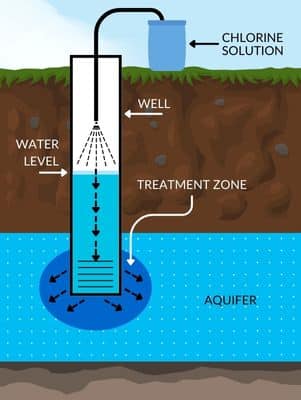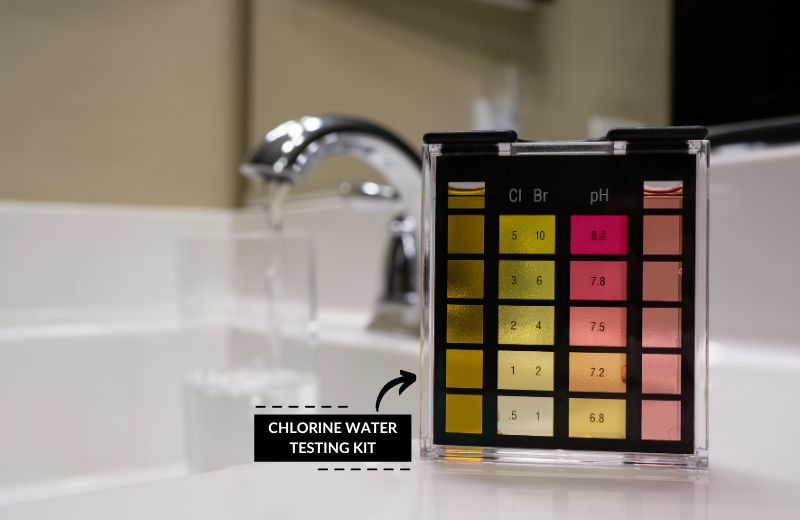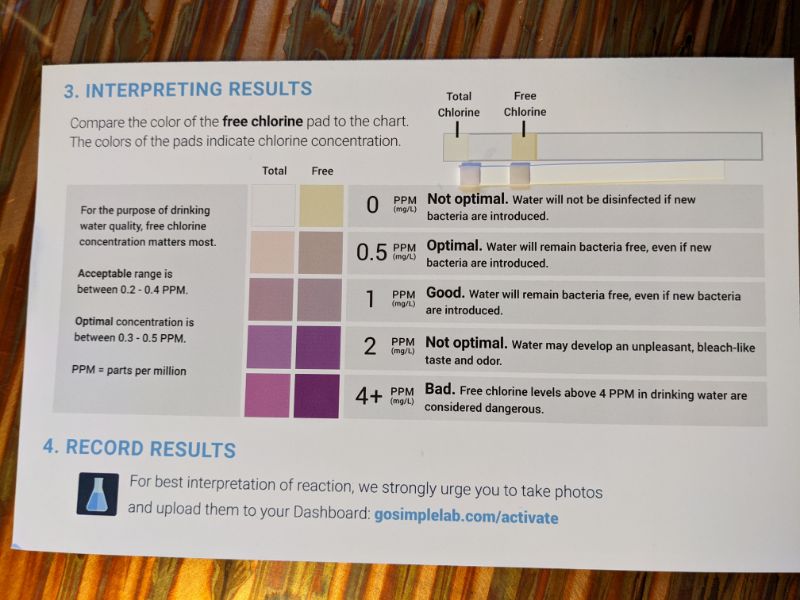It’s recommended that you shock-chlorinate your well every three to five years, or whenever you believe your well has become contaminated or polluted from an outside source. Chlorine bleach kills harmful microorganisms in your water, protecting you from bacterial contamination.
But what happens once you’ve chlorinated your well? How long does it take for the chlorine to dissipate? When is your water safe to drink again?
We’ve answered all these questions and more in this guide.
📖 TL;DR
Depending on the size and depth of your well, it typically takes from 30 minutes to 24 hours for all the chlorine to be removed from your well after shock chlorination.
Table of Contents
🤔 How Long does it Take for Chlorine to Leave your Plumbing after Shock Chlorination?
From the moment you begin the shock chlorination process and chlorine circulates through your well, it’ll take between 30 minutes to a full 24-hour day for all of the chlorine to be removed from the well.
Why is there such a variation in times? Because it depends entirely on the size and depth of your well. While a shallow well may be flushed within half an hour, a large, deep well could take up to 24 hours.
While you’re shock-chlorinating your well, your water supply will carry the strong chlorine solution through your home’s plumbing system, disinfecting all of your pipes, appliances, and water treatment equipment, like water softeners.
Once enough contact time has passed and the well no longer smells of chlorine, you’ll need to open all the faucets in your home and leave them switched on for a few minutes, or until the chlorine smell has gone.
Keep in mind that your hot water faucets may need to run for longer than the cold water faucets to drain the water heater. Leave the faucets on until you can no longer smell chlorine.

🚰 When is Water Safe to Drink After Shock Chlorination?
Generally, your well water should be safe to drink within 30 minutes to 24 hours of shock chlorinating your well. But you might want to wait for longer than 24 hours to allow all the chlorine to leave your plumbing system, or until the chlorine odor has completely vanished.
Check every faucet and shower, including outside faucets and your garden hose, to make sure the chemical scent has dissipated. The safe amount of chlorine in your water is too low to have an odor, so if your water still smells, you know it still isn’t safe to drink.
If you’re sensitive to chlorine, avoid bathing or taking long showers in your water, and wear rubber gloves to wash your dishes, for several days after the shock chlorination process.

🙋♂️ How to Know if your Shock-Chlorinated Water is Safe to Drink
The best way to know whether your shock-chlorinated water is safe to drink is to buy chlorine test strips and test your water. These are available in hardware stores and online.
The Environmental Protection Agency’s Maximum Contaminant Level for chlorine is 4 mg/L. Most chlorine test strips measure chlorine in PPM. Ideally, your test should register between 0.3 and 0.5 PPM of chlorine in your water.
It’s worth conducting this test several times from different faucets in your home to make sure the concentrated chlorine solution has completely left your plumbing system.
Once several tests indicate low, unharmful levels of chlorine, you’re good to drink your water again.
Related: When can I shower after shocking my well?

📖 How to Know if Shock Chlorination has Worked
If you’re shock-chlorinating your well to remove coliform bacteria (e.g. if your well has been contaminated by a septic system), it’s important to test your drinking water again for coliform bacteria one or two weeks after the chlorination process.
If no coliform bacteria show up on your test, it’s safe to drink your water. This is technically the official date that your water is completely safe to drink after chlorination.
For this reason, it’s wise to be cautious with your water use before you do a second test. Boil your drinking water or use bottled water until you know for certain that it’s free from harmful microorganisms.

📰 Alternatives to Shock Chlorination
Not everyone feels comfortable adding such large amounts of chlorine to their water. While you might have to shock chlorinate your water at least once to deal with dangerous contamination, there are some long-term solutions to consider if you want to avoid shock chlorination in the future.
Maintain Your Well Properly
The best way to stay protected from well water contamination is to properly maintain your well and water system. You should get your well serviced by a professional at least once a year, who will check for cleanliness, mechanical problems, and any issues with the structure.
A well water service can assure you that your well casing, pressure tanks, and water system are all functioning as they should. With proper well maintenance, your risk of accidental contamination is much slimmer.

Use a Continuous Disinfection Treatment System
Using a water treatment system that continuously disinfects your water is a good way to consistently protect yourself from microbiological contamination.
Chlorine injection systems are a common treatment option to consider. These systems produce chlorinated water by injecting a measured amount of chemicals into water. They’re essentially a small version of the chlorine injection used by water treatment facilities.
Chlorine injection systems add just the right amount of chlorine to your water to kill microorganisms, so it’s safer than disinfecting your water with a highly-concentrated bleach solution. You shouldn’t notice a chlorine smell or taste from using this system.
Consider a Chemical-Free Option
Shock chlorination is your best response to well water contamination. But if you just want to stay safe from potential contamination, consider using a chemical-free disinfection option, like a UV purifier.
UV purifiers scramble the DNA of viruses, bacteria, and protozoans by emitting ultraviolet rays. This prevents the microorganisms from replicating, so they can’t make you sick.
You can install a UV purifier just after your well water system, so your entire home is protected.
Note: there may be some instances when shock chlorination is the only option. For example, if you’re dealing with iron bacteria, shock chlorination is usually the most effective way to remove this contaminant.

